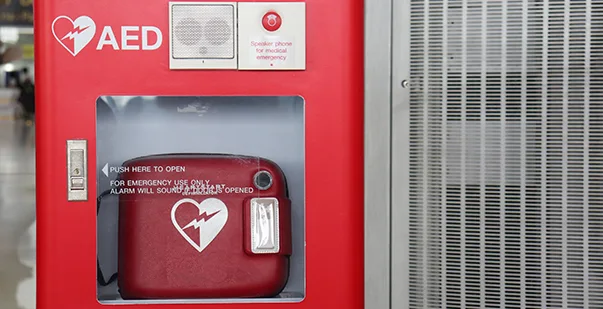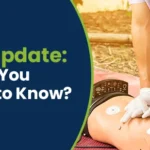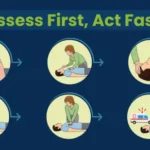Table of Content
- Introduction
- Understanding AED
- Best AED for Home
- Who Needs an AED Defibrillator for Home?
- How Much Does A Defibrillator Cost?
- Factors to Consider While Purchasing Home AED
- Ensure your Family’s Safety in Cardiac Emergencies
More than 3,50,000 people suffer from cardiac arrest in out-of-the-hospital settings across the US, where 70% of incidents occur at home. However, with early defibrillation, it is possible to triple the survival rate in such emergency events. The staggering statistics emphasize the importance of having an AED for home, readily available for immediate access.
Having an AED at your home becomes an essential option to ensure the well-being of your family during cardiac emergencies. However, there is still an ongoing debate about the best AED device for home use, owing to the benefits and risks of various options in the market. Now, how do you find the right one that fits your specific needs, budget, and environment? Read on to find out!
Master ACLS Now
Get ACLS certified with confidence
Understanding AED
An AED, or Automated External Defibrillator, is a lightweight, portable, and life-saving device that delivers an electric shock to the heart in the event of cardiac arrest. It will restore the normal, healthy rhythm during emergencies. They are usually user-friendly devices that offer instructions to guide you through every step of the resuscitation process.
Read More: AED Use on Children and Infants
Best AED for Home
Sudden cardiac arrest has been one of the leading causes of death in the United States for years. But thanks to the innovative AED technology and proper CPR training programs, the statistics are on the decline.
In addition to lifestyle and heart health knowledge, advancements in cardiac care technology have provided us with many home AEDs on the market. Let’s explore the top AEDs for homes and their key features.
Philips HeartStart Home Defibrillator
Philips HeartStart Home Defibrillator is the best AED for a home. It has an 8-year manufacturer’s guarantee, making it an excellent investment. As a world-renowned medical device innovator and FDA-approved manufacturer, Philips has designed this heart-start home defibrillator with the most user-friendly features.
Just pull the repent table and let the Onsite guide in the device guide you step-by-step. It will begin with coaching you through pulling out and applying the defibrillator pads. Then it will guide you through the pad placement on the patient.
The AED and pads are designed with distinct diagrams for pad placements, which will leave no misinterpretation on your part. Moreover, the pads are pre-installed within the device, so you don’t even have to handle the hassles of connecting with the defibrillator. If you have kids in your home, you can also purchase a set of child pads.
Key Features
- Easy-to-use design with precise voice prompts
- In-built SMART pad cartridge that automatically self-tests the defibrillator’s battery and electrodes.
- In-built CPR coaching tool with immediate feedback on the rate and depth of compressions.
- IP55 for water and dust protection
- Built-in metronome to guide you in performing the proper CPR.
Zoll AED Plus
If you are seeking innovation, consider investing in ZOLL AED Plus. The device provides step-by-step visual and audio guidance to properly respond to sudden cardiac arrest so that you can deliver optimal care in those few critical moments.
The best part of the device is that it has a graphical user interface with pictographs of the chain of survival, so you can be confident you will never forget and step in the heat of emergency circumstances. The unit is designed to withstand high altitudes and extreme temperatures, so you are covered in even extreme weather, especially at the time of traveling.
The unit is available in semi-automatic and fully automatic configurations. It includes the defibrillator and user manual, carry case, battery, set of adult pre-installed pads, inspection tag, window decal, and first responder kit.
Key Features
- Color display that shows real-time information, including ECG and compression depth.
- Provides vocal cues to lead you through the shock delivery process.
- In-built metronome feature that gives audible prompts to guide compressions,
- Rescuecoach features to guide through the entire rescue process, including CPR and defibrillation.
- Unique see-through CPR features to analyze the victim’s cardiac rhythm, even performing CPR compressions.
Defibtech Lifeline AUTO
The Defibtech Lifeline AUTO is an ideal personal AED for home use. The device is designed to bridge the gap between the layperson and the professional while offering easy-to-follow guidance and advanced features for experienced users.
It has a two-button operation that ensures maximum simplicity. Just tap on the green ‘On’ button to get started, and the lifeline will coach you through the process until EMTs arrive. If prompted, you have to press the red ‘shock’ button to administer a shock to an unconscious victim/
Its intuitive biphasic technology analyzes the patient to determine if the shock is required. The device will alert you if and when you are required to press the ‘shock’ button. If you require complete automatic capabilities, you can invest in an upgraded device.
Key Features
- Clear and Easy-to-use Interface
- Long battery life that can deliver upto 400 shocks or 4 hours of continuous operation.
- CPR Rate Advisor Feature that provides real-time feedback
- Unique pediatric-pak option for the use of pediatric pads with reduced energy level.
- Durable and robust design that makes it fit for use in extreme conditions.
Read More: What’s the Best AED for Churches?
Who Needs an AED Defibrillator for Home?
People who are prone to heart problems and have a higher risk of experiencing cardiac arrest should invest in AEDs at home. However, keep in mind that even people who seem to be healthy can have an underlying medical condition that might cause a life-threatening emergency.
People who
- Are at risk of sudden cardiac arrest due to a history of heart failure
- Have Known cardiac arrhythmia or other heart conditions
- Have family members who have suffered or passed away due to a heart attack.
These people are more likely to experience the most returns on their investment as there is a high probability that they might experience heart problems or cardiac arrest themselves.
Firefighters, police officers, and other professionals trained in delivering emergency help can also own home AEDs. By investing in the life-saving device, they can make their community a safer place.
Individuals who participate in sports and recreational activities tend to exert excess strain on their hearts. Therefore, they should consider getting an AED at home. Moreover, people living in remote or rural areas should have AEDs at their homes to increase their survival rate until the EMTs arrive at the scene.
How Much Does A Defibrillator Cost?
Despite the significant role of AED in saving lives, the cost of AED makes it out of reach for many regular citizens. The price of AED for purchase will be in the range between $1,100 to $3,500. The prices might vary depending on the various features.
Now you know how much an AED costs, but as with any investment, it is also crucial to evaluate the costs associated with owning the device, from ongoing maintenance to replacement costs. Let’s break down these factors to help you make an informed decision and get you equipped to save lives.
Initial purchase price
The initial purchase price for AED might vary depending on the additional features of the device. It includes,
- ECG monitoring
- manual override options
- exterior housing units
- Extended battery life
- Voice prompts and visual instructions
Choosing the device by balancing the features will help you stay within your budget and meet the specific needs of your situation. Nonetheless, make sure to keep in mind that the initial purchase price is just one part of the total AED cost. Maintenance, replacements, warranties, and support can also impact your overall investment in the device.
Ongoing Maintenance Cost
When you think of how much a defibrillator is, you should always remember to calculate the recurring cost of the accessories that have to be replaced when they expire. Typically, such accessories include electrode pads and batteries, where each component has a specific lifespan that varies depending on the manufacturer and model.
The frequency of replacement and maintenance of these components should be factored into the overall cost of the automatic defibrillator to get a realistic picture of your ownership. In addition, keep in mind that most AEDs have at least an 8-year warranty period. In such a case, you might want to replace the pads three times and the battery at least once.
You should add up these cuts, and you will get an approximate idea of the total investment. Some AEDs offer a battery life of upto 5 years, which singly reduces the frequency of replacements. Considering such data will help you choose the best AED for a home that is both affordable and reliable in an emergency.
Advanced Technology and Rich Features
The latest AED models stand out as advanced life-saving devices due to their unique ability to analyze the vitals of sudden cardiac arrest victims. At the same time, the responder continues to perform hands-on CPR.
The feature is of utmost importance since the customary AED device can only be used when the responder pauses the administration of CPR and waits for the device to complete the analysis. Uninterrupted CPR during the AED analysis process has become a game-changer. Scuh’s innovative design and features will not only improve the life-saving efforts in cardiac emergencies, but they can also be a bit expensive.
Warranty and Support
A Comprehensive warranty and support system when purchasing an at-home AED can give you peace of mind about the budget. It ensures that your AED is covered for essential repairs and replacements due to regular use. It is recommended that you have at least a minimum warranty period of 7 to 8 years when purchasing an AED for your home.
When you are considering an AED device with a limited warranty period, be cautious. Ensure to have a complete understanding of the warranty and support options offered by the manufacturer or provider to make the most out of your AED purchase.
Factors to Consider While Purchasing Home AED
An ideal AED for home is a crucial link in the chain of survival, empowering you to deliver life-saving interventions before the arrival of advanced medical assistance. While you know how much a defibrillator costs, it is also important to analyze other factors to choose the right device for your use. Here are some factors to keep in mind while purchasing AED for your home.
- Ease of Use: When choosing an AED for your home, make sure that it has user-friendly features that the average citizen can easily understand without proper training. The device should offer step-by-step instructions without any misconceptions about CPR and defibrillation.
- Compact Size: If you don’t have plenty of space in your home, choose a compact device that will not draw attention to itself.
- Durability and resilience: The device should have a durable and resistant design to withstand challenging weather conditions. It should also have the highest level of protection against the ingress of dust particles and water in harsh environments.
Ensure your Family’s Safety in Cardiac Emergencies.
Sudden cardiac arrest can attack anyone, anytime, even your loved one, in the comfort of your home. When you or someone in your family is at an elevated risk of cardiac arrest, you will want an AED for home.
When AED treatment is quickly administered along with proper CPR techniques, it increases the victim’s chances of survival and has more positive outcomes in their recovery period. Their presence will give you peace of mind and safeguard your loved ones, making them an inevitable addition to your home for emergency preparedness.







